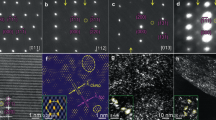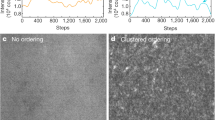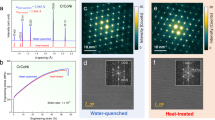Abstract
Complex concentrated solutions of multiple principal elements are being widely investigated as high- or medium-entropy alloys (HEAs or MEAs)1,2,3,4,5,6,7,8,9,10,11, often assuming that these materials have the high configurational entropy of an ideal solution. However, enthalpic interactions among constituent elements are also expected at normal temperatures, resulting in various degrees of local chemical order12,13,14,15,16,17,18,19,20,21,22. Of the local chemical orders that can develop, chemical short-range order (CSRO) is arguably the most difficult to decipher and firm evidence of CSRO in these materials has been missing thus far16,22. Here we discover that, using an appropriate zone axis, micro/nanobeam diffraction, together with atomic-resolution imaging and chemical mapping via transmission electron microscopy, can explicitly reveal CSRO in a face-centred-cubic VCoNi concentrated solution. Our complementary suite of tools provides concrete information about the degree/extent of CSRO, atomic packing configuration and preferential occupancy of neighbouring lattice planes/sites by chemical species. Modelling of the CSRO order parameters and pair correlations over the nearest atomic shells indicates that the CSRO originates from the nearest-neighbour preference towards unlike (V−Co and V−Ni) pairs and avoidance of V−V pairs. Our findings offer a way of identifying CSRO in concentrated solution alloys. We also use atomic strain mapping to demonstrate the dislocation interactions enhanced by the CSROs, clarifying the effects of these CSROs on plasticity mechanisms and mechanical properties upon deformation.
This is a preview of subscription content, access via your institution
Access options
Access Nature and 54 other Nature Portfolio journals
Get Nature+, our best-value online-access subscription
$29.99 / 30 days
cancel any time
Subscribe to this journal
Receive 51 print issues and online access
$199.00 per year
only $3.90 per issue
Buy this article
- Purchase on Springer Link
- Instant access to full article PDF
Prices may be subject to local taxes which are calculated during checkout




Similar content being viewed by others
Data availability
The data generated during and/or analysed during the current study are available from the corresponding author upon reasonable request.
References
Ye, Y. F., Wang, Q., Lu, J., Liu, C. T. & Yang, Y. High-entropy alloy: challenges and prospects. Mater. Today 19, 349–362 (2016).
Miracle, D. B. & Senkov, O. N. A critical review of high entropy alloys and related concepts. Acta Mater. 122, 448–511 (2017).
Wei, S., He, F. & Tasan, C. C. Metastability in high-entropy alloys: a review. J. Mater. Res. 33, 2924–2937 (2018).
George, E. P., Raabe, D. & Ritchie, R. O. High-entropy alloys. Nat. Rev. Mater. 4, 515–534 (2019).
Ma, E. & Wu, X. L. Tailoring heterogeneities in high-entropy alloys to promote strength–ductility synergy. Nat. Commun. 10, 5623 (2019).
George, E. P., Curtin, W. A. & Tasan, C. C. High entropy alloys: a focused review of mechanical properties and deformation mechanisms. Acta Mater. 188, 435–474 (2020).
Li, Z., Pradeep, K. G., Deng, Y., Raabe, D. & Tasan, C. C. Metastable high-entropy dual-phase alloys overcome the strength–ductility trade-off. Nature 534, 227–230 (2016).
Yang, T. et al. Multicomponent intermetallic nanoparticles and superb mechanical behaviors of complex alloys. Science 362, 933–937 (2018).
Lei, Z. et al. Enhanced strength and ductility in a high-entropy alloy via ordered oxygen complexes. Nature 563, 546 (2018).
Gludovatz, B. et al. Exceptional damage-tolerance of a medium-entropy alloy CrCoNi at cryogenic temperatures. Nat. Commun. 7, 10602 (2016).
Liu, C. T. Atomic ordering and structural transformation in the V-Co-Ni ternary alloys. Metall. Trans. 4, 1743–1753 (1973).
Singh, P., Smirnov, A. V. & Johnson, D. D. Atomic short-range order and incipient long-range order in high-entropy alloys. Phys. Rev. B 91, 224204 (2015).
Fernández-Caballero, A. et al. Short-range order in high entropy alloys: theoretical formulation and application to Mo-Nb-Ta-V-W system. J. Phase Equilibria Diffus. 38, 391–403 (2017).
Jian, W. R. et al. Effects of lattice distortion and chemical short-range order on the mechanisms of deformation in medium entropy alloy CoCrNi. Acta Mater. 199, 352–369 (2020).
Ma, Y. et al. Chemical short-range orders and the induced structural transition in high-entropy alloys. Scr. Mater. 144, 64–68 (2018).
Yin, B. L., Yoshida, S. H., Tsuji, N. & Curtin, W. A. Yield strength and misfit volumes of NiCoCr and implications for short-range-order. Nat. Commun. 11, 2507 (2020).
Zhang, F. X. et al. Local structure and short-range order in a NiCoCr solid solution alloy. Phys. Rev. Lett. 118, 205501 (2017).
Oh, H. S. et al. Engineering atomic-level complexity in high-entropy and complex concentrated alloys. Nat. Commun. 10, 2090 (2019).
Ding, J., Yu, Q., Asta, M. & Ritchie, R. O. Tunable stacking fault energies by tailoring local chemical order in CrCoNi medium-entropy alloys. Proc. Natl Acad. Sci. USA 115, 8919–8924 (2018).
Li, Q. J. et al. Strengthening in multi-principal element alloys with local-chemical-order roughened dislocation pathways. Nat. Commun. 10, 3563 (2019).
Ding, Q. et al. Tuning element distribution, structure and properties by composition in high-entropy alloys. Nature 574, 223–227 (2019).
Zhang, R. et al. Short-range order and its impact on the CrCoNi medium-entropy alloy. Nature 581, 283–287 (2020).
Sohn, S. S. et al. Ultrastrong medium-entropy single-phase alloys designed via severe lattice distortion. Adv. Mater. 31, 1807142 (2019).
Sohn, S. S. et al. High-rate superplasticity in an equiatomic medium-entropy VCoNi alloy enabled through dynamic recrystallization of a duplex microstructure of ordered phase. Acta Mater. 194, 106–117 (2020).
Williams, D. B. & Carter, C. B. Transmission Electron Microscopy, A Textbook for Materials Science (Springer, 2009).
Kuwano, N. et al. In situ TEM observation of long range ordering via short range order in Cu3Pt. Bull. Mater. Sci. 22, 697–700 (1999).
Van Tendeloo, G. & Amelinckx, S. The origin of diffuse intensity in electron diffraction patterns. Phase Transit. 67, 101–135 (1998).
Van Tendeloo, G. & Amelinckx, S. On a simple method to determine the origin of diffuse scattering in electron diffraction patterns. Scr. Metall. 20, 335–339 (1986).
Tibshirani, R. Regression shrinkage and selection via the lasso. J. R. Stat. Soc. 58, 267–288 (1996).
Zunger, A. First-principles statistical mechanics of semiconductor alloys and intermetallic compounds. In Statics and Dynamics of Alloy Phase Transformations (eds Turchi, P. E. A. & Gonis, A.) 361–419 (Springer, 1994).
Tamm, A., Aabloo, A., Klintenberg, M., Stocks, M. & Caro, A. Atomic-scale properties of Ni-based FCC ternary and quaternary alloys. Acta Mater. 99, 307–312 (2015).
Zunger, A., Wei, S., Ferreira, L. G. & Bernard, J. E. Special quasirandom structures. Phys. Rev. Lett. 65, 353–356 (1990).
Hÿtch, M. Quantitative measurement of displacement and strain fields from HREM micrographs. Ultramicroscopy 74, 131–146 (1998).
Warren, B. E. X-Ray Diffraction (Dover Publications, 1990).
Acknowledgements
X.W., F.Y. and P.J. were supported by the National Key Research and Development Program of the Ministry of Science and Technology of China (grant numbers 2019YFA0209900 and 2017YFA0204402), the Basic Science Center Program (grant number 11988102), the Natural Science Foundation of China (grant numbers 11972350 and 11890680), and the Chinese Academy of Sciences (grant number XDB22040503). Z.C. and J.Z. were supported by the Basic Science Center Program (grant number 51788104), the National Key Research and Development Program of the Ministry of Science and Technology of China (2016YFB0700402). E.M. thanks Xi′an Jiaotong University for supporting his work at the Center for Alloy Innovation and Design.
Author information
Authors and Affiliations
Contributions
X.W. and E.M. conceived the ideas and supervised the project together with J.Z. X.C. and H.Z. performed the TEM, FFT and geometric phase analysis work. Q.W. conducted the pair correlation analysis, DFT and Monte Carlo simulations. Z.C. designed and carried out the STEM experiments. P.J. prepared the materials, samples and heat treatments. P.J., L.Z., Q.X., M.Z. and F.Y. conducted tensile testing, electron backscatter diffraction observations, and mechanical behaviour analysis. All authors participated in the discussions. X.W. and E.M. wrote the paper.
Corresponding authors
Ethics declarations
Competing interests
The authors declare no competing interests.
Additional information
Peer review information Nature thanks the anonymous reviewers for their contribution to the peer review of this work. Peer reviewer reports are available.
Publisher’s note Springer Nature remains neutral with regard to jurisdictional claims in published maps and institutional affiliations.
Extended data figures and tables
Extended Data Fig. 1 Evidence of CSRO in the fcc phase of VCoNi MEA before tensile deformation.
All results are similar to those after tensile straining shown in Fig. 2. a-1, Micro-area EDP with the [112] zone axis. Arrows point to the arrays of superlattice reflections at \(\frac{1}{2}\{\bar{3}11\}\) positions. a-2, Energy-filtered dark-field TEM image taken using extra reflections. Inset, a close-up view of the area in the dashed-line enclosed square, highlighting an area with CSROs. a-3, Statistics showing the size distribution of CSROs, observed in the dark-field TEM images and inverse FFT images. b-1, FFT pattern of the fcc phase with the [112] zone axis. The yellow circle highlights a diffuse reflection at \(\frac{1}{2}\{\bar{3}11\}\) positions. b-2, Inverse FFT image showing the CSROs (circled) that are superimposed on the fcc lattice image. b-3, Maps of V, V−Co and V−Ni, respectively, showing two CSROs in two arrays by EDS mapping from the HAADF image with the [112] zone axis in an aberration-corrected TEM. All dashed lines mark the (\(\bar{3}11\)) planes intersecting the (\(111\)) plane in plan view: yellow: V-enriched, blue: Co-/Ni-enriched. All scale bars are 0.5 nm.
Extended Data Fig. 2 EDS mapping of the VCoNi alloy with the [112] zone axis.
These are additional maps not included in the main text, showing the distribution of Co, Ni and Co+Ni. The dashed lines in each panel mark (Co,Ni)-enriched {311} planes (blue dashed in Fig. 3), which alternate with V-enriched ones.
Extended Data Fig. 3 Illustration of projecting a (111) plane along [112] and [110] beam directions.
V−Co(Ni) as the nearest neighbour is assumed in this idealized model to be the prevailing CSRO. The numbers 1, 3 and 4 indicate the 1st, 3rd and 4th nearest neighbours, respectively, around a centre atom C. a, Plan view of a close-packed (111) plane, projected along the [112] beam direction. The distance between the nearest points in the [110] direction is r* (compare with Fig. 3d). b, Plan view of the same (111) plane, observed along the [110] beam direction. Unlike for the [112] beam direction, when projected along the [110] beam direction (for example, horizontal dashed lines) the centre atom will be directly superimposed onto two unlike 1st neighbours. This mixed column, when compared with the case in a (no overlapping of unlike species in the column) blurs the difference (and hence the contrast) from the neighbouring columns. [112] is therefore the preferred beam direction to see the CSRO of interest.
Extended Data Fig. 4 Schematic of element occupancy that exemplifies the CSRO taking fcc lattice sites.
a, Two-dimensional lattice structure of the CSRO, deduced from experimental evidence (the alternating pattern of {311} planes in Fig. 2h and of atomic columns in the {111} plane in Fig. 3d). Note that the red (blue) spheres are meant to represent V (Co,Ni)-enriched atom positions, respectively (i.e., red is not yet V only, but still contains some Co and Ni). The boxed region shows the minimum-sized configuration of the CSRO. b, The 3D configuration of the CSRO is based on the motif (left) deduced from observations under both the [112] and [110] z.a. (to be explained in a future publication), and embedded in the fcc matrix (right). Grey spheres indicate random atoms (V,Co,Ni) without chemical order in the fcc lattice. c, Simulated diffraction pattern for the sub-nanometre CSRO configuration embedded in the fcc lattice in b, with the [112] zone axis, showing the extra reflections at the \(\frac{1}{2}\{\bar{3}11\}\) positions (purple diffuse disks).
Extended Data Fig. 5 Strain-field analysis around the CSRO before tensile deformation.
a, Geometric phase analysis strain mapping, superimposed on the lattice image taken with the [110] zone axis. The yellow striped areas with positive strain correspond to the CSROs; two red atoms (V1 and V2) are displayed to represent the V-enriched columns. b, Strain distribution between the two V atoms in a. We note that the spacing between the strain peaks of neighbouring V atoms is 0.28 nm. This figure further illustrates the elastic strains observed in Fig. 4. The atomic radii of V, Co, and Ni are 1.35 Å, 1.26 Å and 1.24 Å, respectively. The larger V atoms and the smaller Co/Ni atoms induce tensile and compressive strain, respectively, in the normal direction of close-packed {\(11\bar{1}\)} planes. The yellow striped bands correspond to the CSROs, with tensile (positive) strain induced by the V-enriched columns in the (\(1\bar{1}1\)) plane. Two V atoms (red) are placed in the figure to mark such columns. The strain distribution between these neighbouring columns (V1 and V2) is shown in b. The spacing between the two strain peaks is 0.28 nm (the average value is 0.3 nm), quite close to the measured spacing between two atomic columns (0.26 nm) based on TEM lattice image. This corroborates that the yellow regions of positive strain are due to the V-enriched columns associated with the CSRO. Nearby regions (blue) experience compressive strain (negative).
Supplementary information
Supplementary Information
This file contains Supplementary Notes 1-3 and Supplementary Figs 1-4, which present details of i) definition of pair correlation coefficient, ii) use of model structures to demonstrate the useful features of pair correlation coefficients, and iii) cluster-expansion-guided Monte Carlo simulations.
Rights and permissions
About this article
Cite this article
Chen, X., Wang, Q., Cheng, Z. et al. Direct observation of chemical short-range order in a medium-entropy alloy. Nature 592, 712–716 (2021). https://doi.org/10.1038/s41586-021-03428-z
Received:
Accepted:
Published:
Issue Date:
DOI: https://doi.org/10.1038/s41586-021-03428-z
This article is cited by
-
Negative mixing enthalpy solid solutions deliver high strength and ductility
Nature (2024)
-
Rejuvenation as the origin of planar defects in the CrCoNi medium entropy alloy
Nature Communications (2024)
-
Harnessing instability for work hardening in multi-principal element alloys
Nature Materials (2024)
-
Three-dimensional atomic structure and local chemical order of medium- and high-entropy nanoalloys
Nature (2023)
-
Multi-scale investigation of short-range order and dislocation glide in MoNbTi and TaNbTi multi-principal element alloys
npj Computational Materials (2023)
Comments
By submitting a comment you agree to abide by our Terms and Community Guidelines. If you find something abusive or that does not comply with our terms or guidelines please flag it as inappropriate.



